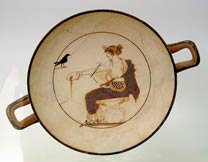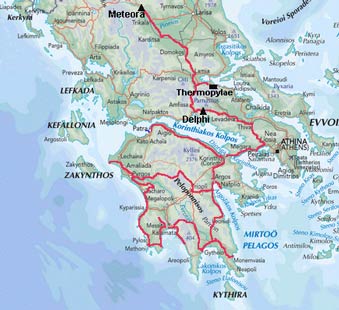 OUR GREEK ODYSSEY - Week 8
OUR GREEK ODYSSEY - Week 8
Week 8 Photos Bottom of page
Return to Index-page
|
We finally left the Peloponnese, crossing the Canal at the Isthmus of Corinth, and travelled north over the pass of Mount Kitharon towards Thebes, city of Oedipus. The road north-westwards from there climbed steadily over the massively impressive bulk of Mount Parnassos, to the modern village of Delphi. Nearby is the archaeological site of the Sanctuary of Pythian Apollo, where in ancient times people came from far and wide to consult the Delphic Oracle, a place considered as the centre of the world. We stayed at Camping Apollon for 5 nights, another 'best camping spot ever', on a terrace at about 2000 feet with the whole of the lower valley spread out below. This unbelievable panorama stretched from the distant Corinthian coast in the far south across the Gulf of Corinth, to the closer Phocian coastline near the small port of Itea. The lower floor of the valley way below us was one massive sea of grey-green olives trees. On the far side, the land rose steadily, with the distant town of Amphissa nestled into the slopes, and high above this, the craggy heights of Mount Giona stretching away to the north with snow still capping its 2,500 m peaks. Above us on the right, the lower slopes of Parnassos towered up with the constant sound of goat bells echoing around the hillside. And the sun setting over the ridge line of Mount Giona was inspirational. Each time we looked up, we simply exclaimed "Wow!" (see Photo 1). Nothing is quite like the site of Apollo's Sanctuary at Delphi, and however many times we visit, it never ceases to inspire amazement. It is easy to see how the site, both for its setting and the prestige of the Oracle, commanded such respect in the ancient world. The site is perched at around 2000 feet on the steep slopes of Mount Parnassos; pilgrims approached the Sanctuary via the Scared Way which winds up the hillside towards the huge Temple of Apollo, where the priestess received questions posed by suppliants and issued the God's garbled responses. From the remains of the Temple, excavated in the late 19th century, we could look down the steep mountain side with the lower slopes covered with olive trees (see Photo 2) right down to the distant Gulf of Corinth. It is a truly awesome sight. Lower down there is another area of shrines, here dedicated to Athena, including the famous partially restored circular temple, the Tholos - see Photo 3. From here, you look across to see the Sanctuary of Apollo high above on the terraced mountainside, and the huge Phaedriades cliffs at whose foot the Castilian spring still flows where pilgrims were required to purify themselves before entering the Sanctuary. The museum contains the magnificent finds from the Delphi excavations (eg the delicately painted bowl at top of page), and we had looked forward to seeing them again. When we were last here in 1999, the museum was being extended (with EEC monies of course); 5 years later, the building works are still unfinished, and worse still, the museum was largely closed with just a few of the exhibits on display. Contrary to our previous feelings, it raises serious questions as to whether the Parthenon Marbles should be returned until the Greeks can prove themselves competent to house them, maintain continuity of public display, and demonstrate accountability for the huge sums of EEC monies being poured into the country. While at Delphi, we visited the Monastery of Osios Loukas, founded by a hermit in the 10th century, and decorated with the most beautiful mosaics (see picture at bottom of page). The architecture, artwork, history and the mountainous setting made this a most inspirational visit. Not so the nearby town of Distomo, the scene of one of World War II's worst atrocities. In June 1944, just days after D-Day, the Germans murdered 232 of the towns civilian population, mostly elderly, women and children, (the memorial records that the youngest victim was 1 month old and the eldest 84), then burnt and looted the town. Angrily, we wondered whether any German had ever been brought to justice for this crime against humanity. It was now time to move on northwards, as the map shows, over the pass between Mounts Iti and Kalidromo, down to the coast near Lamia, for a brief re-visit to Thermopylae, scene of the 300 Spartans' last stand in 480 BC against the Persian invasion of Greece. The memorial, set up on the funeral mound of the small Spartan force, records the lines "Stranger, go tell the Spartans that we lie here, obedient to their words". We paused on our journey northwards to pay our respects. We crossed the broad agricultural plains of Thessaly, again experiencing notorious Greek driving standards, to reach Kalambaka, the next stage of our journey. The town is distinguished for its setting amidst a remarkable geological phenomenon - the rock towers of Meteora. Overshadowing the town are 1000 feet high mesas, as if transported straight out of an Arizona desert film set - bare, bleak grey-brown rocky monoliths, eroded into different shapes, and strangely localised around Kalambaka. The rock towers were formed 25 million years ago from sediments washed down from the surrounding mountains into huge deltas, which over time were compacted by earth movements, uplifted, fragmented and eroded by rivers and weather into the strange shapes we see today. And as if that wasn't enough, from the 14th century, mad monks seeking isolation capped the pinnacles of these monoliths with monasteries. It is from this that the area takes its name, Meteora meaning 'up in the air'. The course conglomerate rock also make the rock towers a real mecca for serious standard rock-climbing. We spent a couple of days packed with geological, botanical and historical interest, scrambling around the monoliths and visiting the monasteries - not for the faint-hearted perched aloft like eyries (see Photo 4). But the weather turned somewhat gloomy which rather spoiled the photographic potential of this curious region. We shall now be moving on to the final stages of our journey, into Epiros in the north west of mainland Greece - coming soon Sheila and Paul Published: Friday 4 June
|
 Week
8 news: Response from the
Delphic Oracle
Week
8 news: Response from the
Delphic Oracle